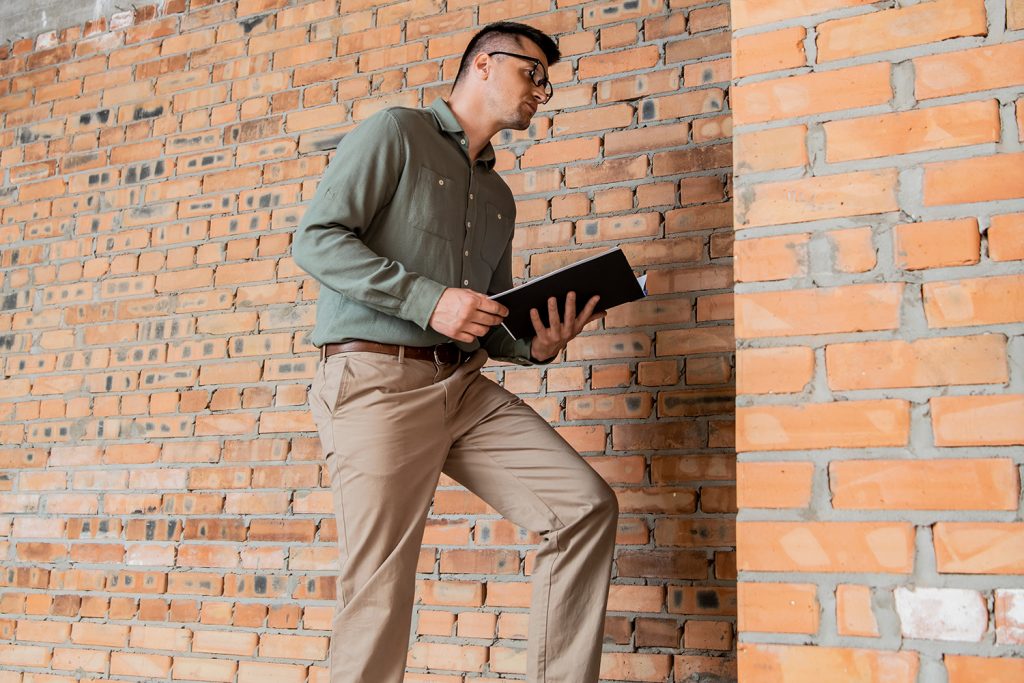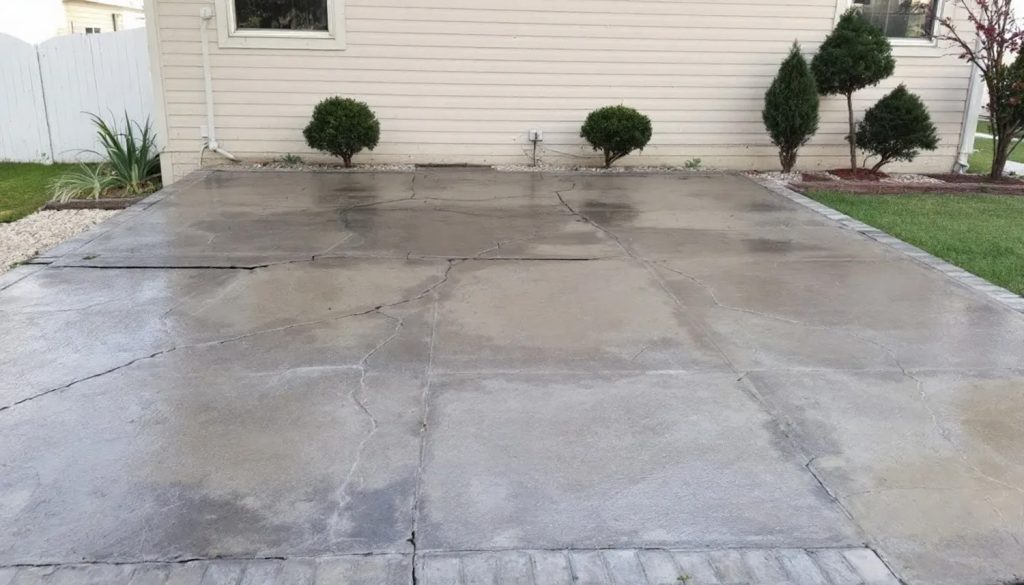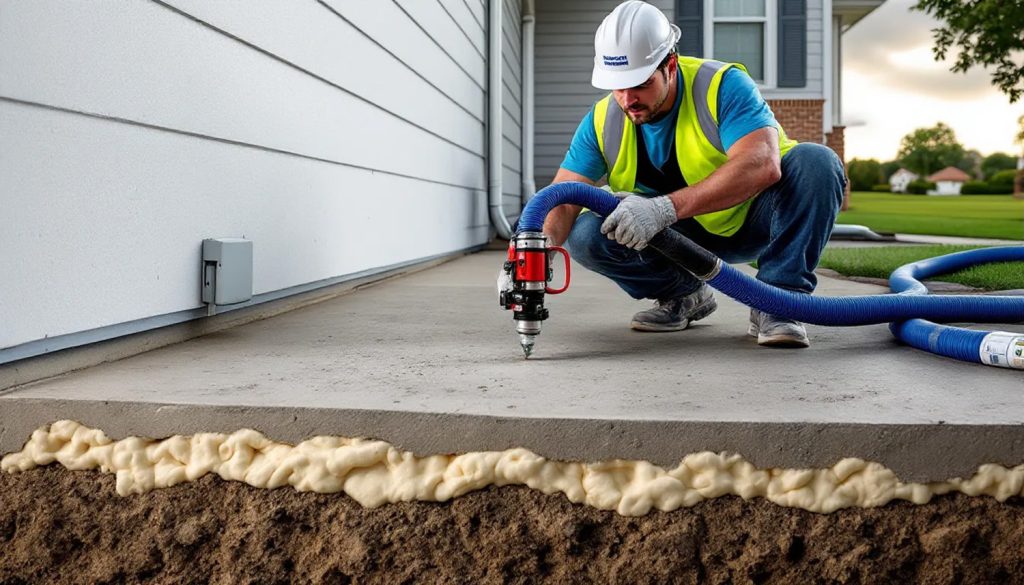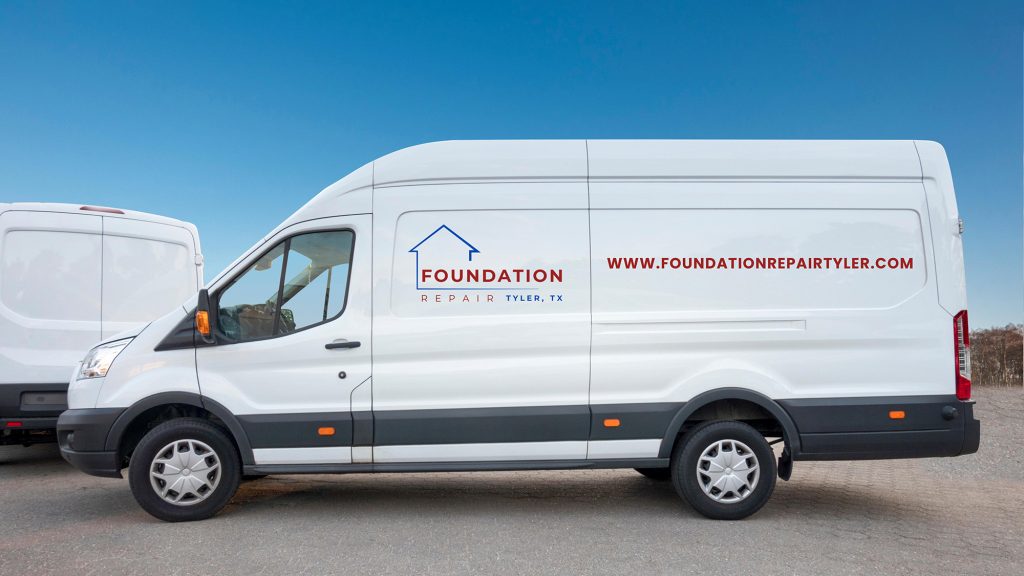Is your home showing signs of foundation trouble? Those cracks in your Tyler home’s slab might seem small now, but they can lead to bigger headaches down the road. Foundation issues don’t fix themselves—they only get worse with time.
When your home’s foundation shows signs of trouble, it’s time to act.
What is a Slab Foundation?
A slab foundation is a large, flat concrete pad that serves as your home’s base. It’s typically 4-6 inches thick and poured directly on the ground. This single piece of concrete supports your entire house structure without a basement or crawl space underneath.
The problem is that as the clay soil of East Texas expands and contracts with moisture under your slab, it sometimes causes voids to develop which put strain on the unsupported concrete.
And there are other potential causes for damage as well, like pipe leaks, rogue tree roots, and erosion. Each has a similar effect: putting pressure or strain on the slab.
Why are Slab Foundations Popular in Tyler?
Slab foundations dominate Tyler homes because they’re cheaper to build than pier-and-beam foundations and provide excellent protection against our moisture-heavy environment. They’re also a solid barrier against pests and reduce construction time for new homes.
Our soil expands during wet, and shrinks during dry, periods. This constant movement wears on your concrete slab over time.
That’s we offer specialized services like slabjacking and void filling to address these types of foundation issues before they worsen to the point of requiring more serious measures like jackhammering through your floor to install piers.
Get Answers:
- Signs You Need Slab Repair
- What Causes Slab Damage?
- Slab Repair Techniques
- Why Early Detection and Repair is Crucial
- Choosing The Right Slab Repair Company
- Cost Considerations for Slab Repair
- Frequently Asked Questions

Start With A Free Inspection (It’s Better To Know)
The best thing to do if you suspect damage to your concrete slab is to get a free inspection to find out what’s causing your issues; whether it’s drainage problems or shifting soil beneath your home.
An inspection typically takes less than an hour and at the end you’ll know exactly what repairs are needed. You’ll get straightforward information about potential solutions like mudjacking, pier installation, or improved drainage systems.
Taking this first step doesn’t commit you to repairs but gives you the knowledge to make educated choices to protect your home.

Signs You Need Slab Repair
When you own a home in Tyler, TX, it’s a very good idea to know what the signs of foundation and concrete slab damage look like -so you can spot them when they start to occur and save yourself time, money, and trouble in the long run.
Cracking Walls and Floors
Cracks in your walls, floors, and ceilings appear when your concrete slab settles or shifts unevenly beneath your home. Thin cracks gradually widen over time and are often the first indication your slab needs professional attention.
Doors and Windows That Won’t Budge
When doors and windows suddenly stick or won’t close properly, your foundation is likely shifting. This happens as your concrete slab moves, twisting door frames and window casings out of their original alignment.
Uneven or Sloping Floors
If you’ve noticed round objects rolling across your floor or furniture that appears crooked, your floors are sloping due to foundation issues. This unevenness occurs when sections of your concrete slab sink into voids beneath your home.
What Causes Slab Damage?
Foundation problems are almost universal among Texas homeowners because of conditions that exist essentially everywhere in the state -but particularly in the clay heavy regions like East Texas.
The most common causes of foundation damage are:
Soil Movement and Its Impact
When it rains, this soil expands dramatically, pushing against your slab. During dry spells, the soil shrinks away, leaving parts of your foundation unsupported. This ongoing cycle causes stress on your concrete slab, leading to cracks and uneven settling over time.
Plumbing Leaks And Foundation Issues
Water leaks beneath your slab can silently damage your foundation for months before you notice. When pipes break under your home, they saturate the soil in concentrated areas, causing uneven lifting or settling. This creates stress points in your concrete slab that eventually crack.
Poor Drainage and Foundations
Improper grading, clogged gutters, or disconnected downspouts allow water to pool around your foundation, causing some sections of soil to expand more than others. This creates uneven pressure on your slab foundation.

Slab Repair Techniques
We use a variety of methods to fix damaged slabs; each technique addresses a different type, or severity, of damage, and they’re used individually or combination with other techniques to level and stabilize your foundation safely.
Slabjacking: Lifting it Up
Slabjacking raises sunken concrete slabs by filling voids underneath them. Slab repair experts in Tyler drill small holes in your concrete slab and inject a special mixture of soil, cement, and water or polyurethane foam beneath it. This mixture fills empty spaces and gently lifts the slab back to its original position.
Piering: Steady as it Goes
Piering stabilizes severely damaged foundations by creating deep structural support. This technique involves installing foundation piers that extend from your concrete slab down to stable soil or bedrock beneath your home. These piers act like underground pillars, transferring the weight of your house to solid ground rather than unstable clay.
Epoxy Injections: Fixing Those Cracks
Epoxy injections seal and strengthen cracked concrete slabs without major reconstruction. Your foundation repair specialist injects high-strength epoxy directly into the cracks, filling them completely and creating a waterproof bond that’s often stronger than the original concrete. This technique is ideal for stopping hairline cracks from becoming more serious.
Why Early Detection and Repair is Crucial
Catching slab foundation problems early can save you thousands in repair costs and prevent serious structural damage to your Tyler home. Small cracks or slight unevenness might seem minor today, but they’re warning signs of bigger troubles ahead.
The Cost of Ignoring Slab Problems
Foundation issues never fix themselves—they only get worse with time. When you ignore early signs like small cracks or sticking doors, you’re setting yourself up for more extensive damage to your home’s structural integrity. Water can seep through foundation cracks, causing mold, rotting wood, and even compromising electrical systems. What starts as a simple slab repair can quickly escalate into a major renovation project costing 3-4 times more than early intervention would have.
Keep in mind, that we can often use minimally invasive techniques like void filling or simple slab leveling if your foundation problems are caught early.
Plus, foundation repair can reduce your water waste if leaking pipes under the slab are part of the issue.

Choosing the Right Slab Repair Company in Tyler
Experience matters when it comes to slab repair in Tyler. Our team offers the full range of foundation repair services like slab repairs, home leveling, and pier & beam repairs based on years of experience.
Responsiveness is also key. We pride ourselves in being responsive, timely, and delivering on our promises.
Too many contractors do fine work but don’t listen to their customers effectively and fail to provide their customers the confidence they’d like to feel when undergoing such a significant repair project.
And, unfortunately, size does matter. Smaller outfits can struggle to cover their upfront expenses and have to charge you more before work is completed to perform the job.
Cost Considerations for Slab Repair
Slab repair in Tyler runs anywhere from $1,000 for small cracks to over $10,000 for major foundation issues. The size of the damage plays a huge role in what you’ll pay.
Hairline cracks? They’re cheap to fix compared to large structural problems that affect your whole home. That’s why it’s so important to catch these problems early -it can save you thousands in repairs.
Your repair costs also depend on which method works best for your situation. Slabjacking (sometimes called mud jacking) typically costs less than installing piers. Polyurethane foam injection for filling voids under your concrete slab is usually more affordable than complete underpinning services that foundation repair contractors might recommend for severe damage.
But, these less invasive options only resolve minor foundation issues. At a certain level of damage, you’re only left with the more expensive (and invasive) options.
Frequently Asked Questions
What are the common signs of foundation trouble in homes?
Common signs include cracking walls and floors, widening cracks, sticking doors and windows, and uneven or sloping floors. You might notice your door frames or window casings becoming misaligned. These symptoms indicate that your concrete slab is settling unevenly or shifting.
Why are foundation problems common in Tyler, Texas?
Foundation issues in Tyler are primarily caused by shifting in the clay soil that’s everywhere in East Texas. It expands when wet and contracts when dry, creating a cycle that stresses foundations. Additional factors include plumbing leaks, invasive tree roots, and erosion of various forms.
What is a slab foundation and why is it popular in Tyler?
A slab foundation is a large, flat concrete pad typically 4-6 inches thick that serves as the base for homes. Slab foundations are popular in Tyler because they’re cost-effective, suitable for the moisture-heavy environment, and provide resistance against pests. However, they require specialized care due to the region’s challenging clay soil conditions.
What is slabjacking and how does it repair foundations?
Slabjacking is a repair technique that raises sunken concrete slabs by filling voids underneath them. Professionals drill small holes in the slab and pump in a mixture of soil, cement, and water or polyurethane foam. This lifts the slab back to its original position and provides stable support. It’s less invasive and typically more affordable than complete foundation replacement.
How much does slab repair cost in Tyler, Texas?
Slab repair costs in Tyler range from $1,000 for minor cracks to over $10,000 for major foundation issues. Most homeowners spend between $2,000 and $10,000. Costs depend on damage extent, repair methods used, and accessibility issues. Slabjacking or polyurethane foam are generally less expensive than pier installation or a complete underpinning.
What happens if foundation problems are ignored?
Ignoring foundation problems leads to escalating damage and significantly higher repair costs. Minor issues like small cracks can develop into severe structural problems affecting walls, floors, and the entire home’s integrity. Additional complications may include mold growth, compromised electrical systems, and plumbing damage. Early detection can save thousands in repair costs and prevent safety hazards.
What techniques do foundation repair specialists use in Tyler?
Foundation repair specialists in Tyler primarily use three techniques: slabjacking to raise sunken slabs, piering to stabilize severely damaged foundations by extending support to stable soil, and epoxy injections to seal and strengthen cracked concrete. These methods are selected based on the specific foundation issues and tailored to Tyler’s unique soil and climate conditions.
Can plumbing issues cause foundation problems?
Yes, plumbing leaks are a significant cause of foundation problems. Leaking pipes saturate the soil beneath the foundation, creating stress points and causing the slab to shift or crack. When addressing foundation issues, it’s important to identify and repair any plumbing problems simultaneously to prevent recurring damage.
How long do slab foundation repairs typically last?
When performed correctly by experienced professionals, slab foundation repairs can last for decades. The lifespan of repairs depends on using appropriate techniques for Tyler’s soil conditions, addressing underlying causes like drainage issues, and implementing preventative measures.
